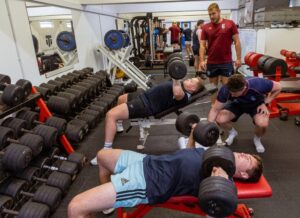When it comes to rugby fitness, the playbook often involves the expected elements: cardiovascular conditioning, agility drills, and endurance training. Yet, there are three game-changing elements that might not be the first things that come to mind. In this article, we’ll explore how plyometric training, strength training, and losing body fat can be unexpected but highly effective tools to boost your fitness for rugby.
1. Plyometric Training: Unleashing Explosive Power
Plyometric training, often associated with sports like basketball and track, might not be an immediate go-to for rugby players. However, its benefits in enhancing explosive power can be a game-changer on the field.
Why it Works:
- Muscle Activation: Plyometrics involve rapid contractions and extensions of muscles, activating fast-twitch muscle fibers crucial for quick bursts of power.
- Improved Coordination: Jumping, bounding, and hopping drills enhance neuromuscular coordination, improving your ability to change direction rapidly, a key aspect of rugby agility.
How to Incorporate:
- Box Jumps: Leap onto a sturdy box, focusing on exploding upward with each jump.
- Bounding: Perform exaggerated, powerful strides, covering as much ground as possible with each bound.
- Jump Squats: Incorporate explosive jumps into your squat routine, emphasizing height and speed.
2. Strength Training: The Hidden Engine of Rugby Prowess
Strength training might seem like a given, but its impact on rugby fitness goes beyond mere muscle development. It’s about building a resilient, powerful body that can withstand the rigors of the game.
Why it Works:
- Increased Force Production: Strength training builds the raw power needed for tackles, scrums, and explosive sprints.
- Injury Prevention: Strengthening supporting muscles and stabilizers reduces the risk of injuries, keeping you on the field.
How to Incorporate:
- Compound Lifts: Embrace squats, deadlifts, and bench presses for overall strength.
- Functional Movements: Include rugby-specific exercises like sled pushes, farmer’s walks, and sled pulls.
- Periodization: Rotate between phases of strength-focused and power-focused training to optimize results.
3. Losing Body Fat: Enhancing Speed and Endurance
While body fat loss might not be directly associated with rugby fitness, maintaining a lean physique has surprising benefits for speed, agility, and overall endurance.
Why it Works:
- Improved Speed: Less body fat means less mass to move, enhancing your ability to accelerate.
- Enhanced Endurance: A leaner body requires less energy to move, contributing to increased stamina over the course of a match.
How to Incorporate:
- Balanced Nutrition: Focus on a diet rich in lean proteins, complex carbohydrates, and healthy fats.
- High-Intensity Interval Training (HIIT): Integrate HIIT sessions to maximize calorie burn and boost metabolism.
- Consistent Cardio: Include regular cardio sessions to promote fat loss while maintaining overall fitness.
Conclusion: Elevating Your Rugby Fitness Game
Plyometric training, strength training, and body fat loss might not be the most obvious elements in a rugby fitness regimen, but they hold the potential to transform your performance on the field. As you embrace these often overlooked aspects, remember the importance of consistency and gradual progression. Integrate them into your training routine, monitor your progress, and watch as these unexpected keys unlock new levels of fitness and prowess, setting you apart on the rugby pitch. In rugby, as in life, sometimes the most surprising strategies yield the most remarkable results.




